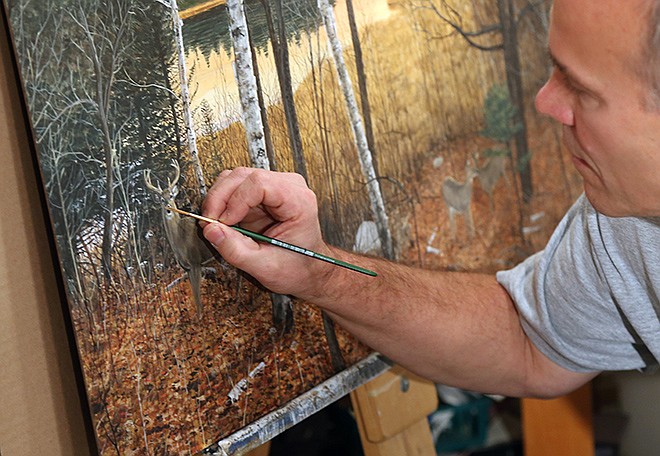LAKEVILLE, Minn. (AP) - A casual viewer wouldn't even have noticed. But Stephen Hamrick knew the neck of the buck in the foreground of his painting was a little too thin for a late autumn scene. With a narrow brush, he carefully made the neck a bit fuller, then added some highlights to the antlers to capture the last rays of the setting sun.
"I would like to put a bigger rack on there," said Hamrick, but his customer wants just an eight-point buck because that's what he sees on his property. "It's hard because a big buck is darned exciting."
It's that attention to detail that has made Hamrick a Minnesota star in the intensely competitive world of wildlife painting, where artists take part in fish and wildlife stamp competitions at the state and national level. These stamps aren't for postage - they're sold to fund wildlife programs and conservation efforts, and they bring in millions.
The publicity helps artists make a living selling limited-edition prints of their winning entries and boosts their prestige among collectors and dealers. The dominance of one family in the pursuit even rated a mention in the Oscar-winning film "Fargo."
Wildlife art resonates among its fans because it transports them to the outdoors, collectors and dealers say. Not surprisingly, hunters and anglers make up a significant part of the customer base, though its appeal is broader than that. The Upper Midwest and Southeast are hotbeds, art dealer Chris Knutson said, but he has made sales to every state, as well as Canada and other countries.
"Good wildlife art appeals to sportsmen and women, reflects their experience in the outdoors. It's very romantic," said John Schroers, a former president of the Minnesota Waterfowl Association who owns a picture framing shop.
Hamrick, 58 - comparatively young in a field dominated by older artists - pulled off a rare feat this fall when his painting of walleyes on the prowl made him only the second artist ever to win all five of Minnesota's fish and wildlife stamp competitions. Now he has his eye on the ultimate prize in the world of wildlife painting - winning the Federal Duck Stamp Contest.
"The waterfowl stamp is a huge contest, very competitive," Hamrick said, adding, "And it's a nice feather in your cap, not only for bragging rights but also financially."
That competition typically includes the Hautmans, three Minnesota brothers who've won a combined 10 times and were noted in a subplot of "Fargo" - made by their childhood friends, Joel and Ethan Coen. Not only are the Hautmans' works prized by collectors, but their designs appear on a huge range of home decor, from rugs and blankets to shower curtains and toilet seats.
Robert Hautman agreed that the challenge of the federal contest is that it attracts so many good artists.
"There's a lot of good painters out there. It's not easy to win," Hautman said. "You've got to get lucky."
Over 190 artists entered in 2014. Hamrick said it's "kind of a sore spot" that he's never been a finalist.
The federal duck stamp has generated more than $800 million in sales since 1934, which has been used to buy or lease over 6 million acres of wetlands for waterfowl habitat. The Minnesota Department of Natural Resources averages about $2.4 million in annual revenue from stamp sales, which mainly goes toward habitat improvement and protection. Other states have similar programs. Wildlife art sales are also important fundraising tools for conservation groups such as Ducks Unlimited and Pheasants Forever.
While the industry isn't as lucrative as it was back when Hamrick began doing wildlife art full-time in 1981, he said original paintings and sculptures are probably 75 percent of his business now. Paintings typically sell for around $5,000 but can reach $10,000 for a big piece, while his prints go for $75 to $100.

